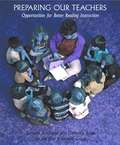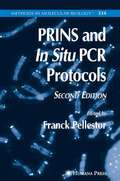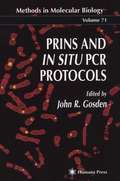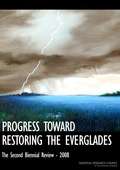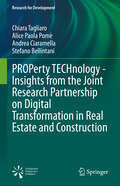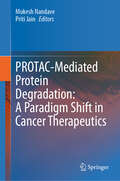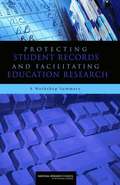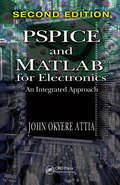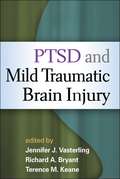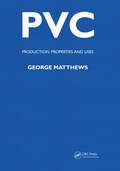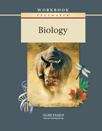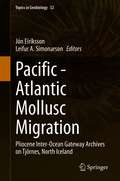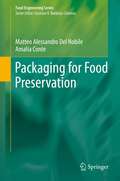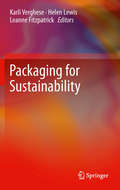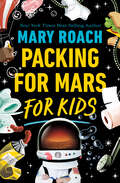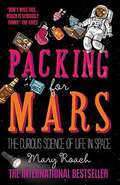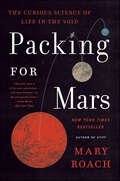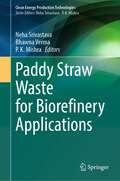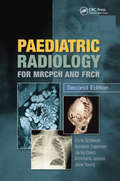- Table View
- List View
PREPARING OUR TEACHERS: Opportunities for Better Reading Instruction
by Catherine Snow Dorothy StricklandToday’s teachers face huge challenges, especially for teaching reading in the primary grades. They must understand as much as possible about how children develop and learn, what they know, and what they can do. They must be able to apply a variety of teaching techniques to meet the individual needs of students. Equally important, teachers must identify students’ strengths and weaknesses and plan instructional programs that help students make progress. But a recent study reveals that fewer than half of American teachers report feeling “very well prepared” to meet such challenges.Preparing Our Teachers seeks to improve that statistic by extracting practical information from the groundbreaking report issued by the National Research Council in 1998. This new book carefully outlines what classroom teachers need to know and what they need to be able to do to give children in preschool through grade 4 the essential opportunities to become good readers. It discusses what teacher education programs need to do to make their students good teachers of good readers and looks at what schools and school districts need to do to keep their teachers up to date for teaching reading.Students at risk for educational failure represent the fastest growing segment of our school population. Preparing Our Teachers demonstrates to educators, parents, and policy makers alike that the first and most enduring way to meet children’s literacy needs is to support their teachers and teachers-to-be.
PRINS and In Situ PCR Protocols
by Franck PellestorThis completely revised and updated edition takes advantage of the many new developments and applications that have occurred in PRINS and in situ PCR technology, including a new fast multicolor PRINS method for identifying human chromosomes, PRINS protocols for in situ detection of unique sequences and point mutation analysis, a new dideoxy PRINS procedure, and in situ PCR and PRINS protocols for plants. The authors describe in detail various applications of PRINS in human (detection of gene deletions in cancer detection of fetal cells in maternal blood, and assessment of aneuploidy in brain tissues and embryos) as well as plant cells. Readily reproducible in situ PCR techniques are also presented for the detection of cytomegalovirus, and for use in combination with microdissection. In situ RT-PCR techniques are also given for use in plant or cancer investigation.
PRINS and In Situ PCR Protocols
by John R. GosdenCutting edge researchers demonstrate step-by-step how oligonucleotide primers may be successfully used to detect and amplify or extend complimentary sequences in situ. Through these procedures-often invented by the authors-the door is opened to rapid identification and characterization of chromosomal DNA sequences, viral genomes, and rare messenger RNAs in cells-at hitherto unmatched degrees of sensitivity and specificity. Their innovative techniques-suitable for both novice and experienced researchers-have rapidly become indispensable for many clinical diagnostic procedures, whether in quantification of chromosomes in the identification of aneuploidy for prenatal diagnosis, or in the identification of viral infection in the early stages, or of rare messenger RNAs present in cells.
PROGRESS TOWARD RESTORING THE EVERGLADES: The Second Biennial Review - 2008
by National Research Council of the National AcademiesThis book is the second biennial evaluation of progress being made in the Comprehensive Everglades Restoration Plan (CERP), a multibillion-dollar effort to restore historical water flows to the Everglades and return the ecosystem closer to its natural state. Launched in 2000 by the U.S. Army Corps of Engineers and the South Florida Water Management District, CERP is a multiorganization planning process that includes approximately 50 major projects to be completed over the next several decades. Progress Toward Restoring the Everglades: The Second Biennial Review 2008 concludes that budgeting, planning, and procedural matters are hindering a federal and state effort to restore the Florida Everglades ecosystem, which is making only scant progress toward achieving its goals. Good science has been developed to support restoration efforts, but future progress is likely to be limited by the availability of funding and current authorization mechanisms. Despite the accomplishments that lay the foundation for CERP construction, no CERP projects have been completed to date. To begin reversing decades of decline, managers should address complex planning issues and move forward with projects that have the most potential to restore the natural ecosystem.
PROPerty TECHnology - Insights from the Joint Research Partnership on Digital Transformation in Real Estate and Construction (Research for Development)
by Andrea Ciaramella Chiara Tagliaro Alice Paola Pomè Stefano BellintaniThe book presents insights from over five years of research by the Real Estate Center at the Department of Architecture, Built environment and Construction engineering (ABC) of Politecnico di Milano, within the Italian PropTech Network initiative. It explores how digital technology is addressing key challenges in the built environment, such as climate change, urbanization, rising costs, and demographic shifts. Traditionally slow to adapt, the real estate sector must embrace innovation to meet urgent Sustainable Development Goals. Focusing on digitalization, the book analyzes tools and technologies that can transform property management, enhance market processes, and add value for stakeholders. It provides a broad literature review, defines PropTech, and examines its role in reshaping the construction and real estate industry. Case studies illustrate the sector&’s ongoing transformation while critically evaluating different PropTech applications. The book contributes to academic debate and supports real estate professionals navigating digital transformation by systematizing current knowledge. It also highlights potential risks, emphasizing the need for further research to ensure sustainable and informed innovation.
PROTAC-Mediated Protein Degradation: A Paradigm Shift in Cancer Therapeutics
by Mukesh Nandave Priti JainThis book is a comprehensive coverage of the ubiquitin-proteasome system and its involvement in cancer progression, and the application of PROTACs in different types of cancer treatment. The book discusses a unique perspective and comprehensive knowledge of the potential of PROTACs to transform cancer therapies. It provides an overview of the history, mechanisms, chemistry, design considerations, and different technologies involved in PROTACs. Additionally, it explains the ubiquitin-proteasome system, its impact on various diseases, and the principles and mechanisms of UPS. The book also describes the chemistry and design aspects of PROTACs and their role in various types of cancers. Finally, it covers the pharmaceutics aspect of formulation design, global requirements, and toxicological aspects of PROTACs. This book is targeted at cancer researchers, medical oncologists, bioinformatics, computational biologists, pharmacologists, medicinal chemists, formulation scientists, regulatory authorities, and policy makers.
PROTECTING STUDENT RECORDS AND FACILITATING EDUCATION RESEARCH: A Workshop Summary
by National Research Council of the National AcademiesDesigned to protect the privacy of individual student test scores, grades, and other education records, the Family Educational Rights and Privacy Act (FERPA) of 1974 places limits the access of educational researches, and slows research not only in education but also in related fields, such as child welfare and health. Recent trends have converged to greatly increase the supply of data on student performance in public schools. Education policies now emphasize education standards and testing to measure progress toward those standards, as well as rigorous education research. At the same time, private firms and public agencies, including schools, have replaced most paper records with electronic data systems. Although these databases represent a rich source of longitudinal data, researchers' access to the individually identifiable data they contain is limited by the privacy protections of FERPA. To explore possibilities for data access and confidentiality in compliance with FERPA and with the Common Rule for the Protection of Human Subjects, the National Academies and the American Educational Research Association convened the Workshop on Protecting Student Records and Facilitating Education Research in April 2008.
PSPICE and MATLAB for Electronics: An Integrated Approach, Second Edition (VLSI Circuits)
by John Okyere AttiaUsed collectively, PSPICE and MATLAB are unsurpassed for circuit modeling and data analysis. PSPICE can perform DC, AC, transient, Fourier, temperature, and Monte Carlo analysis of electronic circuits with device models and subsystem subcircuits. MATLAB can then carry out calculations of device parameters, curve fitting, numerical integration, nume
PTSD and Mild Traumatic Brain Injury
by Jennifer VasterlingEvents that lead to traumatic brain injury are often also psychologically traumatic. Addressing a growing need among mental health practitioners, this authoritative book brings together experts in both posttraumatic stress disorder (PTSD) and mild traumatic brain injury (mTBI). Chapters present empirically based best practices for conceptualization, assessment, and intervention. The book also addresses the biological and psychosocial mechanisms by which PTSD and mTBI complicate each other; management of commonly associated conditions, including chronic pain and substance abuse; special considerations in military contexts; and possible ways to improve the structure and cost-effectiveness of providing care in this challenging area.
PVC: Production, Properties and Uses
by G. MathewsA study on the production, properties and uses, of PVC, Polyvinyl chloride which is the world's third-most widely produced synthetic plastic polymer by the Institute of Materials, London in 1996
Pacemaker Biology
by Globe FearonBiology is the study of living things and the principles that determine how living things function.
Pacemaker Biology: Classroom Resource Edition (3rd Edition)
by FearonContains a wealth of material that integrates and supports the study of the chapters and lessons in Pacemaker® Biology Student Edition as it aims in building the necessary science skills of the students
Pacemaker Biology: Workbook
by Pearson EducationThis comprehensive full-year program introduces students to the basic concepts and principles of biology and builds the fundamental science skills students of all ability levels need to succeed. Pacemaker Biology integrates technology, everyday applications, careers, and modern leaders into biology. Lexile Level 760 Reading Level 3-4 Interest Level 6-12
Pacemaker General Science (3rd edition)
by Globe FearonThis book teaches about three different areas of science: life science, physical science, and earth science. You will learn about living things, including plants and animals. You will study motion and forces, such as those that affect a thrown baseball and a roller coaster racing along on its track. You will come to better understand the features of the Earth, including its oceans and moon. When you finish this book, you will be prepared to continue studying any field of science you choose. You will be on the road to success in the 21st century.
Pacific - Atlantic Mollusc Migration: Pliocene Inter-Ocean Gateway Archives on Tjörnes, North Iceland (Topics in Geobiology #52)
by Leifur A. Símonarson Jón EiríkssonThis volume sheds new light on the marine fauna and geological setting of the Tjörnes Sequence, North Iceland, which is a classic site for the Pliocene and Pleistocene stratigraphy of the North Atlantic region. Readers will discover descriptions of new data collected by the editors over a period of over three decades on marine faunal assemblages and sedimentology available for palaeoenvironmental reconstructions, as well as the tectonic and stratigraphical relationships on Tjörnes Peninsula. The book includes a comprehensive account of all the collections of marine fossil invertebrate macrofossils and foraminifera known to the editors from the Tjörnes Sequence. It is expected to elucidate sedimentological and faunal changes from relatively stable Pliocene conditions to highly variable and periodically harsh climatic conditions of recurring Quaternary glaciations. The distribution, recent or fossil, of various species is recorded and pertinent ecological and biological features are also discussed. The Tjörnes Sequence records the Neogene migration of Pacific species into the North Atlantic. Researchers in geology, climate science, environmental science and earth science will find this book particularly valuable.
Packaging for Food Preservation
by Amalia Conte Matteo Alessandro Del NobileThe book will be focused on the three most important aspects of food packaging: Modeling, Materials and Packaging Strategies. The modeling section will provide a complete overview of mass transport phenomena in polymers intended for food packaging applications. The materials section will cover the most interesting problem-solving solutions in the field of food packaging, i.e., low environmental impact active films with antimicrobial activity. Lastly, the packaging section will provide an overview of the most recent approaches used to prolong the shelf life of several food products.
Packaging for Sustainability
by Helen Lewis Leanne Fitzpatrick Karli VergheseThe packaging industry is under pressure from regulators, customers and other stakeholders to improve packaging's sustainability by reducing its environmental and societal impacts. This is a considerable challenge because of the complex interactions between products and their packaging, and the many roles that packaging plays in the supply chain. Packaging for Sustainability is a concise and readable handbook for practitioners who are trying to implement sustainability strategies for packaging. Industry case studies are used throughout the book to illustrate possible applications and scenarios. Packaging for Sustainability draws on the expertise of researchers and industry practitioners to provide information on business benefits, environmental issues and priorities, environmental evaluation tools, design for environment, marketing strategies, and challenges for the future.
Packing for Mars for Kids
by Mary Roach“America’s funniest science writer” (Washington Post) asks the questions children ask in this young readers adaptation of her best-selling Packing for Mars. What is it like to float weightlessly in the air? What happens if you vomit in your helmet during a spacewalk? How do astronauts go to the bathroom? Is it true that they don’t shower? Can farts really be deadly in space? Best-selling Mary Roach has the answers. In this whip-smart, funny, and informative young readers adaptation of her best-selling Packing for Mars, Roach guides us through the irresistibly strange, frequently gross, and awe-inspiring realm of space travel and life without gravity. From flying on NASA’s Weightless Wonder to eating space food, Packing for Mars for Kids is chock-full of firs-hand experiences and thorough research. Roach has crafted an authoritative and accessible book that is perfectly pitched to inquiring middle grade readers.
Packing for Mars: The Curious Science of Life in Space
by Mary RoachWhat happens when you vomit during a space walk? The bestselling author of Stiff explores the irresistibly strange universe of space travel and life without gravitySpace is devoid of the stuff humans need to live: air, gravity, hot showers, fresh veg, privacy, beer. How much can a person give up? What happens when you can't walk for a year? Is sex any fun in zero gravity? What's it like being cooped up in a metal box with a few people for months at a time? As Mary Roach discovers, it's possible to explore space without ever leaving Earth. From the space shuttle training toilet to a 17,000 mile-per-hour crash test of NASA's space capsule (cadaver stepping in), she takes us on a surreally entertaining trip into the science of living in space.
Packing for Mars: The Curious Science of Life in the Void
by Mary Roach“America’s funniest science writer” (Washington Post) explores the irresistibly strange universe of life without gravity in this New York Times bestseller.The best-selling author of Stiff and Bonk explores the irresistibly strange universe of space travel and life without gravity. From the Space Shuttle training toilet to a crash test of NASA’s new space capsule, Mary Roach takes us on the surreally entertaining trip into the science of life in space and space on Earth.
Packs: Strength in Numbers
by Hannah Salyer★ "Part natural science, part deep ecology, wholly captivating."—Kirkus, STARRED review★ "A must-purchase for every collection." —School Library Journal, STARRED review An exquisitely illustrated celebration of animals who live in packs, herds, pods, and more—including humans. Vivid art and exuberant vocabulary are perfect for emerging readers and parents looking for nonfiction picture books for home learning. Packs shows how togetherness and teamwork are the keys to survival of any species, and the many ways we rely on one another."Showing how different animals benefit from living and working in groups, Salyer&’s debut is a great example of the inventiveness possible in a nonfiction picture book."—New York Times Book Review Groups, packs, herds of millions, and more—our world teems with animals on land, air, and sea.Packs is an inspiring celebration of how togetherness helps many creatures thrive, in both nonhuman and human communities. Hannah Salyer&’s stunning selection reminds us that teamwork is universal, there is brilliance in biodiversity, and there is strength in numbers. Includes an author&’s note encouraging community engagement and activism, as well as a fun visual index of the animals featured.
Paddy Straw Waste for Biorefinery Applications (Clean Energy Production Technologies)
by P. K. Mishra Neha Srivastava Bhawna VermaThis book provides an exclusive and critical in-depth analysis of paddy straw waste valorization at a broad scale for different industrial applications. It explores and discusses the various valorization pathways of paddy straw into valuable products connected to biorefineries' products and byproducts. The book also examines the scope, potential, and availability of paddy straw in the field of biorefineries. Various lignocellulosic biomasses with expanded potential are known for their industrial applications, even at a broad pilot range. Among these biomasses, paddy straw has emerged as the most suitable lignocellulosic waste for various biorefinery applications. Paddy is a crucial and widely consumed crop globally, and it generates the highest annual production of waste compared to other cereal crops. The cellulose content, accounting for approximately 47% of the total cellulosic biomass, offers significant potential for valorization, along with hemicellulose and lignin, which can also be explored and expanded on an industrial scale. However, despite the tremendous scope for valorization, lignocellulosic biomass-based biorefineries face cost-effectiveness challenges that need to be addressed for sustainable and uniform expansion, distribution, and economic scalability in various applications. The book's specific feature lies in its targeted and specific valorization of paddy straw into biofuels and other biorefinery-based products, which hold promising industrial applications and easily scalable approaches for mass production. This book is an essential resource for students, scientists, engineers and practitioners working in the biorefinery industry and academia.
Paediatric Cardiac Anaesthesia: A Primer for the General Anaesthetist
by Jutta ScheffczikThis book outlines how to approach the anaesthetic for congenital heart disease patients for non-cardiac surgery, how to plan for it and to provide a blueprint on how to anaesthetise any congenital cardiac lesion. It describes the physiology of congenital cardiac conditions (unrepaired and repaired) which is important for anaesthetic planning and contains anatomical drawings of the lesions with explanation on how the physiology of these lesions influences anaesthetic technique and how anaesthesia influences the lesion. One of the challenges of congenital cardiac conditions is their variability, which needs to be taken into account in any teaching material. With most congenital patients surviving to adulthood, every anaesthetist will come across these patients, regardless of where they work or which specialty they anaesthetise for. Paediatric Cardiac Anaesthesia: a Primer for the General Anaesthetist provides specific information regarding the management of patients with a cardiac lesion and the risks with a general anaesthetic when troubleshooting does not include crashing onto cardio-pulmonary bypass. It is aimed at non-cardiac anaesthetists including anaesthetic trainees who need to learn about congenital cardiac lesions and anaesthetising for it and non-cardiac consultants who anaesthetise cardiac patients (both paediatric and adult) for non-cardiac surgery. It can be used by trainees for learning about it or by consultants for refreshing their memory.
Paediatric Forensic Medicine and Pathology
by Anthony Busuttil Jean KeelingChild abuse and suspicious child deaths are very complicated matters for clinicians, pathologists, law enforcement officials and legal professionals to investigate. Meanwhile, the evidence base for forensic pathology, especially in paediatrics, is steadily growing.
Paediatric Radiology for MRCPCH and FRCR, Second Edition
by Chris Schelvan; Annabel Copeman; Jacky Davis; Annmarie Jeanes; Jane YoungRadiology plays a fundamental role in the diagnosis and management of childhood diseases. This is reflected in both paediatric and radiology post graduate exams, where candidates are expected to have a working knowledge of paediatric pathology, clinical manifestations and appropriate radiological investigations. Building on the great success of the first edition, Paediatric Radiology for MRCPCH and FRCR retains the popular preexisting structure of the book, but presents an improved variety of clinical cases as well as updated text in-keeping with advances in medical practice and technology. There is more emphasis on cross-sectional imaging, as candidates are increasingly encountering these sophisticated imaging tests in postgraduate exams. Images have been updated, and all the clinical information has been reviewed and revised accordingly.Contains over 100 clinical cases, presented in exam format, with answers overleaf Includes a wide range of common and rare paediatric conditions with supplementary images to illustrate additional points Uses classic examination images, with salient radiological and clinical summaries of each condition - the "hot lists" Carries specific information for paediatricians and radiologists for each case An introductory chapter on the basic concepts of imaging aims to provide the reader with an approach to radiological imaging and an awareness of the different modalities available, with new sections on non-accidental injury and radiation protection.
